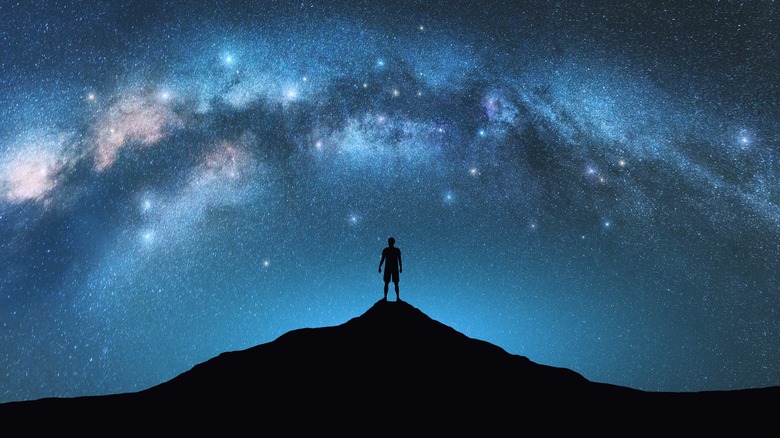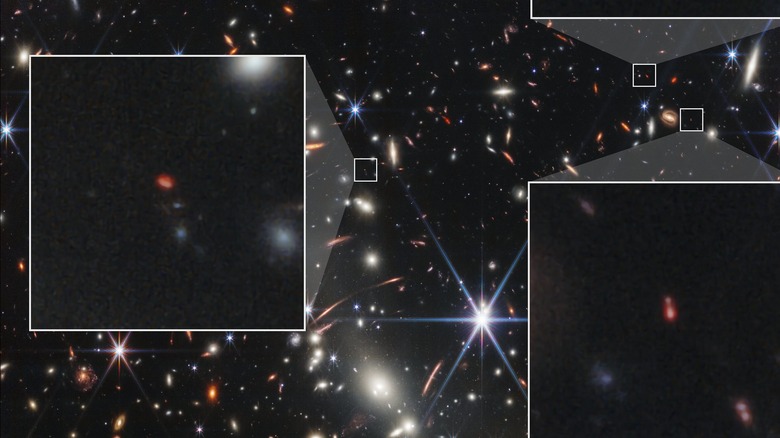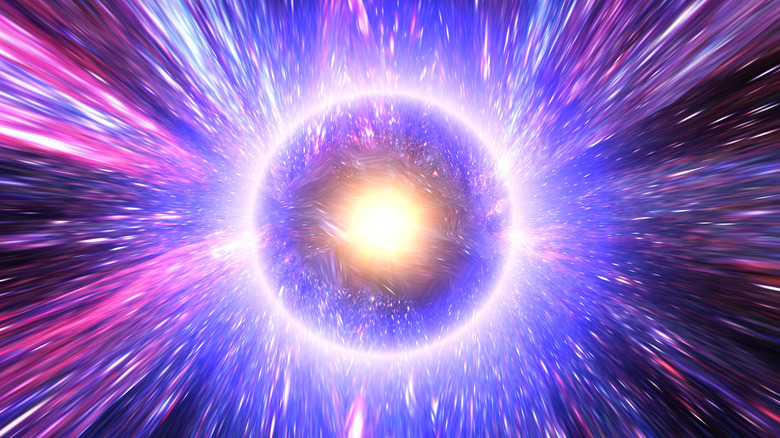The James Webb Telescope Discovery That Defies How We View The Universe
When the James Webb Space Telescope (JWST) launched on Christmas Day 2021, researchers expected nothing short of a marvel. The heretofore unknown secrets of the early cosmos revealed? Check. Groundbreaking imagery of jaw-dropping fidelity of enough megapixels — 122, in fact — to put iPhone tech-bros to complete shame? Check. At 10 billion dollars, the most expensive telescope in history that fully and absolutely justifies its 30-year-long development process and all the effort and energy therein? Check. And now that the JWST has been tucked in its gravitationally locked Lagrange Point (L2) in the shadow of Earth for a little over a year, we've already got enough material to work with to keep astrophysicists busy for years.
Case in point: the JWST's photos of the early universe. When the JWST was under construction, researchers specifically wanted to use the array to peer as far into the past as possible. Lest you lose track of how that's possible, remember that nothing moves faster than the speed of light. The universe is about 13.8 billion years old (per Space.com), and Live Science tells us that the JWST can see light that's been traveling toward us for up to 13.5 billion years. Researchers used to believe that the first stars — just individual stars — cohered from gas about 400 million years after the Big Bang. But as Space.com continues, the JWST has taken pictures of entire galaxies spinning in the void 500 to 700 million years after the universe formed.
A fast-track to maturity
It really shouldn't be possible for galaxies as mature as our own Milky Way to exist at a time when the universe was 3% of its current age. It's as though the galaxies and their stars had a "fast-track to maturity," as PBS News Hour cites Ivo Labbé, astrophysicist at Swinburne University of Technology in Australia. It's basically like a 2-year-old toddler looking like a 60-year-old man.
The standard cosmological models say the universe rapidly inflated in its earliest fractions of seconds, as Forbes outlines. From then it continued to expand all the way to the present. Before stars existed, the cosmos passed through its hot soup "dark age" when electrically charged ions blocked the passage of all light, per Space.com. As soon as things cooled down, gas cloud particles started sticking together, and voila: stars, then galaxies. All that is still basically true. But thanks to the James Webb Space Telescope, we know that our timeline and details are wrong.
The study that compiled this information came out on February 2023 in the journal Nature. Not only is it "just crazy that these things seem to exist," as Science News quotes study co-author Lisa Grossman, the stars in these early galaxies are also way, way more massive than should make sense, as Smithsonian Magazine says — the largest is as colossal as 100 of our own suns. The largest star in our own Milky Way, by contrast, is about the size of 60 suns.
A not-so-dark age, after all
So what gives? What are some potential explanations for these mature early universe galaxies? At this point, the most honest answer would be a giant shoulder shrug. On Science News, astronomer Emma Curtis-Lake of the University of Hertfordshire very plainly states, "The formation and growth of black holes at these early times is really not well understood." She also makes it clear that the new information doesn't discredit our current cosmological model, but merely that we've got to update the model.
And yet, on the peer-review publication EurekAlert!, astronomer and astrophysicist at Penn State — and co-author of the current study — Joel Leja calls these newly discovered galaxies "universe breakers" because they shatter what he calls "settled science." He admits that no one really knew what they'd find when the James Webb Space Telescope started sending back images of the early universe. But no matter how we cut it, the new discoveries mean that the mass of stars in the universe's first several hundred years was up to 100 times greater than expected. On that point, Emma Chapman, astrophysicist at the University of Nottingham, suggests on The Guardian that the aforementioned "dark age" of the cosmos "may not have been so dark, after all."
Even so, even study co-author Leja isn't fully convinced of the findings. On EurekAlert!, he says, "I think there is a real possibility that a few of these objects turn out to be obscured supermassive black holes."


